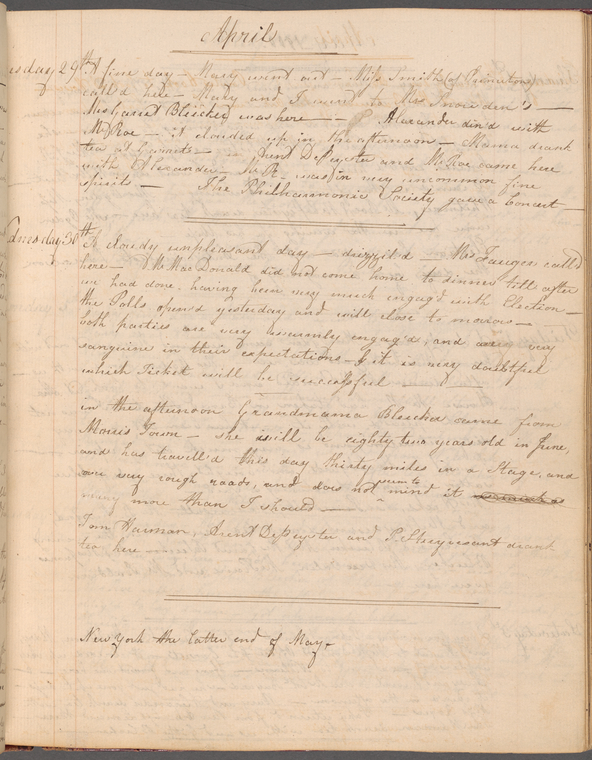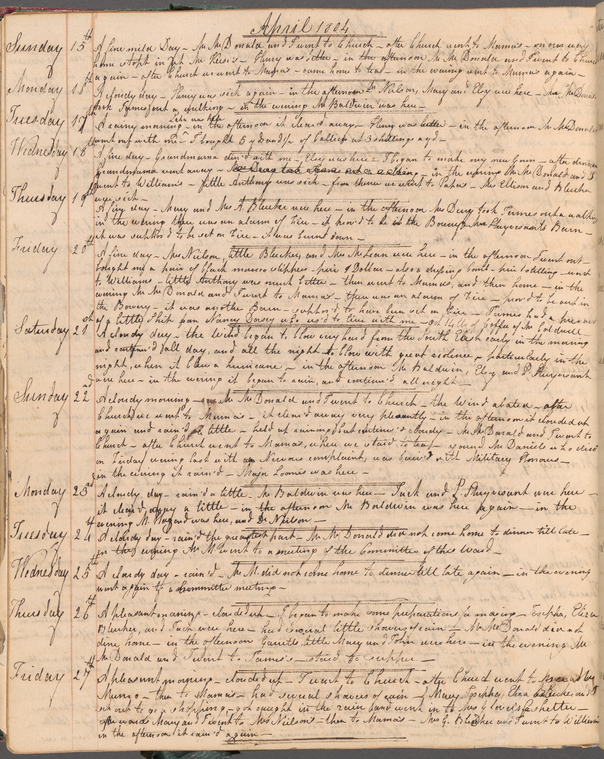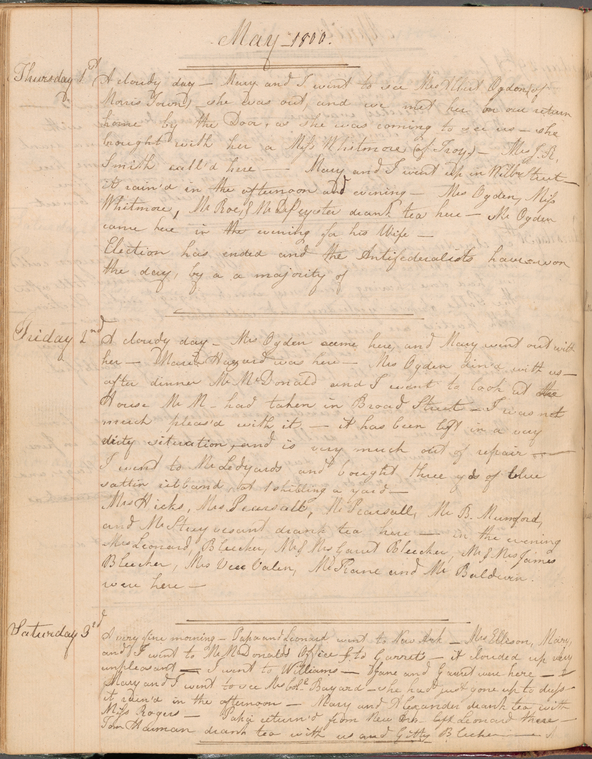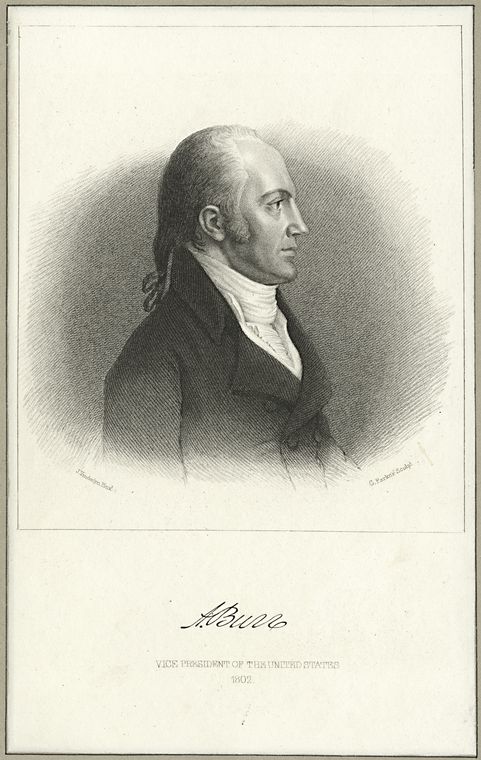Elizabeth De Hart Bleecker Diary, April 30, 1800
“Mr MacDonald did not come home to dinner till after we had done, having been very much engag’d with Election—the Polls open’d yesterday and will close to morrow—both parties are very warmly engag’d, and are very sanguine in their expectations—& it is very doubtful which ticket will be successful” -Elizabeth De Hart Bleecker, April 30, 1800.
It doesn’t seem like much, but the fact that Alexander MacDonald did not make it home for dinner on April 30, 1800 underscores the deep significance of the 1800 New York State legislative elections. Tellingly, this wasn't the last time an election again got in the way of family dinner. The infamous gubernatorial and legislative contests of 1804, which led to the duel between Alexander Hamilton and Aaron Burr, also kept Elizabeth Bleecker’s husband from coming “to dinner till late,” because he had to attend “a meeting of the committee of the ward” the night polls opened.
In 1800, MacDonald missed his supper in vain. The next day, May 1st, Bleecker noted that the “Election has ended and the Antifederalists have won the day, by a majority of...” She never filled in the final vote margins. The Republicans—who Bleecker derisively called Antifederalists, the coalition that had opposed the United States Constitution over a decade earlier—won every one of New York City’s assembly seats by about 300 or so votes, out of a total 5,700-plus that were cast. The results probably disappointed Bleecker, her husband, and their neighbors. The second ward, where they lived—running from Nassau Street to the East River, and bounded by Pine Street to the south and Peck Slip to the north—was the most staunchly Federalist enclave of the City. There, voters cast more than twice as many ballots for Federalists than for Republicans.
Though Federalists retained their majority in certain wards in the southern reaches of Manhattan island, the Republican sweep of the 1800 Assembly elections in the City was a stunning change of fortunes. Just one year earlier, Federalist candidates beat Republican candidates by about 1,000 votes, of the 5,100 or so ballots cast. In Bleecker’s Second Ward, voters had sided with Federalists five-to-one in 1799.
What had changed? The obvious conclusion would seem to be that 1800 was a presidential election year. Certainly, it was not a coincidence that MacDonald’s missed or delayed dinners both coincided with presidential election years. In this period, the State Assembly and Senate chose New York’s delegates to the Electoral College; one's vote in the legislative elections was also an indirect vote in the presidential contest. 1800 stands out, in particular, as an election season for the ages. Turnout in New York City for the 1800 assembly elections, at over 70% of eligible voters, was higher than in any previous election.
Yet we should not assume that the primacy of presidential elections in our own political culture was also true in the early-nineteenth century. Local considerations figured in deeply in these elections. In fact, rather than national politics shaping the local, in the case of 1800, local City politics helped determine the presidential election.
What really changed was that, in 1799, Aaron Burr got the state legislature to charter the Manhattan Company, which would ostensibly provide clean water to New Yorkers. Burr, though, had bigger plans. He wrote into the charter provisions that effectively allowed the Company to act like a bank. This mattered because up until this point, members of the Federalist Party dominated the City’s two banks—the Bank of New York, and the New York branch of the Bank of the United States. Many people believed that Federalists played politics with the banks, distributing and restricting credit to serve partisan ends. Many artisans, in particular, bemoaned that these banks’ lending practices worked against them.
The Manhattan Company provided an antidote on both fronts. First, Burr ensured that members of the Republican Party dominated the Company’s board of directors. The Republican Party in New York was made up of a number of distinct factions built around individual leaders. By bringing these factions together in one institution, and binding them financially, the Manhattan Company unified the opposition to the Federalists. Second, the Company then opened up access to credit to many of the artisans who had a tense relationship with existing banks. This drew artisans—whose rocky relationship with the Federalist Party ran back to the ratification of the Constitution—firmly into the Republican orbit.
By both consolidating the Republican Party at the highest levels, and broadening its base at the grassroots, Burr’s Company transformed the City's political dynamics. The rise of the Republicans in Manhattan helped tip the balance of power in the state legislature enough that, later that year, New York cast its electoral votes for the Republicans’ Jefferson/Burr ticket. Some Federalists--including Bleecker’s father, Anthony L. Bleecker—ironically had invested in the Manhattan Company. They made a profit, but at the expense of their party’s local and national political fortunes.
Of course, Burr still famously almost played the spoiler in the presidential election. At the time, the person who received the most electoral votes became president, and the runner-up became vice-president. Thomas Jefferson ended up receiving the same number of electoral votes as Burr, the presumptive vice-presidential candidate. Burr did not willingly back down. Though his intransigence sparked a constitutional crisis, it was Burr’s work in New York City that helped get the Republican ticket elected in the first place. The hero at the local level played the villain on the national stage.
How exactly Elizabeth De Hart Bleecker experienced these turbulent political times and what she thought about them remains obscure. That is, outside of the few cold dinners she noted in her diary.
This is the third in a series of monthly posts highlighting entries from the Elizabeth De Hart Bleecker Diary. Previous installments in the series include a broad overview description of the diary, and posts featuring entries about labor in early New York and another about a sensational murder trial.
Further Reading:
On the connections between the Manhattan Company, the New York State legislative elections of 1800, and the presidential election, see Brian Phillips Murphy, “‘A very convenient instrument’: The Manhattan Company, Aaron Burr, and the Election of 1800,” William and Mary Quarterly 65 (April 2008), 233-266; and Robert E. Wright, “Artisans, Banks, Credit, and the Election of 1800,” Pennsylvania Magazine of History and Biography 122 (July 1998), 211-239. On turnout in New York, see John L. Brooke, “‘King George Has Issued Too Many Pattents for US’: Property and Democracy in Jeffersonian New York,” Journal of the Early Republic 33 (Summer 2013), 187-217. My analysis of election results relied on the election returns compiled by Philip J. Lampi and made available through “New Nation Votes: American Election Returns, 1787-1825,” an NEH-funded project run by Tufts University and the American Antiquarian Society.
About the Early American Manuscripts Project
With support from the The Polonsky Foundation, The New York Public Library is currently digitizing upwards of 50,000 pages of historic early American manuscript material. The Early American Manuscripts Project will allow students, researchers, and the general public to revisit major political events of the era from new perspectives and to explore currents of everyday social, cultural, and economic life in the colonial, revolutionary, and early national periods. The project will present on-line for the first time high quality facsimiles of key documents from America’s Founding, including the papers of George Washington, Thomas Jefferson, Alexander Hamilton and James Madison. Drawing on the full breadth of the Library’s manuscript collections, it will also make widely available less well-known manuscript sources, including business papers of Atlantic merchants, diaries of people ranging from elite New York women to Christian Indian preachers, and organizational records of voluntary associations and philanthropic organizations. Over the next two years, this trove of manuscript sources, previously available only at the Library, will be made freely available through nypl.org.
Read E-Books with SimplyE
 With your library card, it's easier than ever to choose from more than 300,000 e-books on SimplyE, The New York Public Library's free e-reader app. Gain access to digital resources for all ages, including e-books, audiobooks, databases, and more.
With your library card, it's easier than ever to choose from more than 300,000 e-books on SimplyE, The New York Public Library's free e-reader app. Gain access to digital resources for all ages, including e-books, audiobooks, databases, and more.
If you don’t have an NYPL library card, New York State residents can apply for a digital card online or through SimplyE (available on the App Store or Google Play).
Need more help? Read our guide to using SimplyE.



